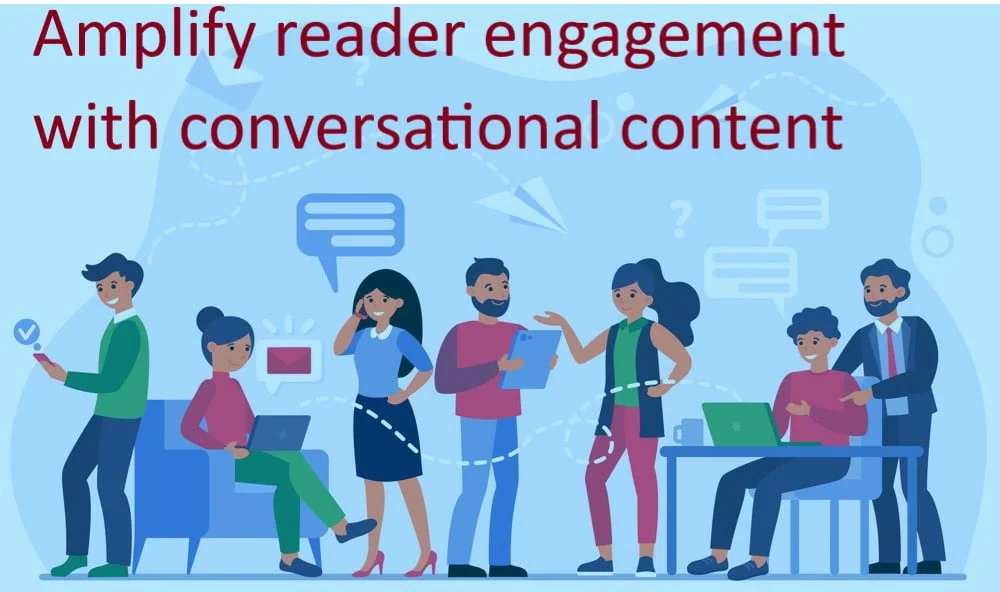You may often come across web pages or blog articles that miserably fail at catching your attention. As a reader, you not only avoid reading such a piece of information, but also close the very website right away.
Being a content writer, you want the people to read your content. But what if it lacks engagement and no one reads it? You won’t want this nightmare to be happening to your content as a writer, would you?
Why conversational content?
Needless to say here that any writer would want to engage and convince the readers. And no, the hefty vocabulary won’t help you out. Instead, what would come in handy here is writing in a conversational tone.
Conversational content writing entices, engages, and entertains the reader!
You would want to induce an inner voice in the reader’s psyche that talks to them through your words. Besides, every reader desires to be addressed personally.
And conversational writing is the only means for you to address each reader individually. Moreover, you would not want your tremendous efforts to go into vain just because it doesn’t establish a connection with the reader, right?
How to get conversational content right?
But most of us do not know how to achieve the perfect levels of conversational and compelling content writing. The main reason is that we have been taught to use a more formal style whenever it comes to writing.
But guess what? You’re not in school anymore!
Which means you don’t need to abide by the school laws anymore. All you need to do is overstep the boundaries of traditional formal writing.
There may not be a rulebook for conversational writing to engage with digital buyers. However, the following tips may aid you in writing more engagingly and conversationally-
Ask Questions & Pique Reader Interest
Asking questions is a brilliant way of getting a hold of your reader’s attention. Questions replicate a conversational feel. As a result they play a vital role in engaging your readers. They also deliver a broader prospect in limited words. Questions naturally trigger your problem-solving instincts.
A vital conversational technique.
It works on the basic principles of curiosity. A question takes over your consciousness and prevents your brain from beholding any thought but from looking for the answer! And that’s how a question makes your content more engaging by hijacking the readers’ consciousness.
In fact, real-life conversations are nothing but sets of answers to different questions we ask each other!
Let’s look at an example to have a better understanding-
By asking, “Have you ever watched one of the Harry Potter movies?” you will inadvertently steer your readers to contemplate the knowledge they have about Harry Potter.
You get them informed and psychologically prepared for what they are going to read about. That, too, even without having to elaborate on your subject vividly!
Use Shorter Sentences
Longer sentences have more information. More information means more work for your brain to process the words. And by the time you complete reading a longer sentence, your brain gets tired.
The result is a loss of information. You may even have to re-read a longer sentence to understand what it says. And eventually, you give up on reading the content with extensive sentences!
Longer sentences tend to be complicated. And using more of them increases the overall complexity of your content. Besides, your mind itself perceives the longer sentences to be tough to process. It automatically negates the charisma of your content.
Don’t let that happen!
Curb the reader dropout rate with shorter sentences. Attract and engage them effectively. Shorter sentences are simple to read. Plus, they serve information in smaller pieces, which enables your mind to process it with ease. Besides, it also takes less of your time & effort to write shorter sentences.
For instance, any reader would prefer reading-
“The weather was bad. There were lightning and rain. Victor could barely see the road ahead.”
…as compared to a tiring sentence like –
“The bad weather with heavy rain and blinding lightning thunders made Victor almost blind as he could barely see the road ahead of him.”
Avoid Complex Vocabulary
You might often fall under the delusion that using hefty vocabulary will make your content more attractive. The reality is somewhat different. Complex terminology gives you a sense of being a superior content writer. But as a reader, you tend to avoid reading words that are difficult to understand.
Complex vocabulary adds unnecessary weight to your sentences.
It is a troublesome task for a reader to carry too many toilsome words in mind simultaneously. And adding a lot of them to your content is not a good idea.
It will require your reader to put in extra effort to understand your content’s overall meaning and intention. And owing to the low comprehensiveness, readers will drop out and leave your content unread.
Any reader will better understand, “Remembering you on your birthday” over, ”Reminiscing thou on thy natal day.”
Avoid Passive Voice
“The subject doing the action is the sentence’s object”… Confusing, isn’t it? That is what passive voice is – confusing at times. But above all, the passive voice sentences are way wordier than the active ones! And naturally, difficult to keep up with.
Now think about it, how would you like to sound while talking to a friend? Casual, obviously! And that is precisely how you would want to sound to your readers.
And the thing with passive voice is that it makes sentences very unclear and hard to understand. For instance, have a look at these two sentences-
“My journey to Europe began with extreme enthusiasm. I’ll never forget it.”
“My journey to Europe will be remembered by me as to how enthusiastically it began.”
It’s apparent that you would like the first one more because it is clearer and easier to understand. In contrast, the second one is cloudy and hard to follow.
Learn Your Audience’s Informality Level
This is another critical aspect of conversational writing. It will help you a lot if you know who your target audience is. Youth, elders, homemakers, business people- everyone responds to a specific vocabulary. And this vocabulary is influenced by the prevailing verbal informality/ formality among the target peers.
Make the audience feel like you are one of them.
Design the vocabulary, tempo, and flow of your content in accordance with the degree of formality that your audience responds to. Let’s try to understand with examples and invite two different groups of people over dinner using different levels of formality-
“Hey, pals, I’m hosting a dine out for y’all at mine tonight, say 8-ish? Make it on time!”
”Hello friends, I have organized a dinner party at my house tonight. You are cordially invited to join us. Please ensure that you reach by 20:00 hours. Thank you”
You can use the slangs to lure a young audience. At the same time, it will be wise to stick to formal writing styles and a couple of idioms to attract somewhat sophisticated readers.
But be cautious of avoiding this approach when you do B2B content writing. They need to see words that are serious, concise, and to the point.
Ditch grammar rules to spice up the content
Formal writing lacks creativity. But with informal writing, you’ll have nothing to hold back. Write your heart out. Break the grammar rules if that’s what it takes. And most importantly, keep your reader at the center.
Let there be omissions and errors!
One such grammar law says that you cannot end a sentence with a preposition. But, sometimes, if you don’t finish a sentence with a proposition, it sounds dull and erratic even though it’s grammatically correct! For instance, “It’s good to know where you get your habits from” sounds better than “It’s good to know from where you are getting your habits.”
Snub the grammar nazis. After all, you’re writing to please your readers and not them.

Add lots of “you”
The most pivotal word you would like to add to your vocabulary to make the content more conversational is “You.” A simple three-letter word that totally changes the perception of the reader.
The regular formal writing addresses a hall full of readers and lacks intimacy. But with conversational content, you make interpersonal conversations through your words. And it’s “you” that makes it possible to have a one-on-one conversation with your reader.
I want to catch your attention, how can I do this? Well, by simply focusing on “you”!
But how do you make it about “you”?
This is where your creative mind comes into play. All you have to do is pretend as if you are talking to your friends. Next, write down whatever you are talking about. This way, not only you’ll be engaging your reader, but they’ll also feel that the content is attuned to them.
Use “I” to establish brand trust
Do you want to establish trust with your readers? Do you want enhanced engagement with your readers? Start using addressing yourself with first-person singulars.
“We” has a more collective approach. Whereas “I” sounds more personal and intimate. Moreover, the author addressing itself as “I” induces a feeling of invested interpersonal conversation.
Besides, “you” cannot have a conversation alone. It’s “you” and “I” that talk with each other. Even though the “I” is not tangible in your content, it makes your writing capable of inducing a two-way conversation. And that’s what you would want to achieve with conversational writing.
Using first-person singulars in your content development indicates that you’re thoughtful and considerate about your reader. You’re not physically present with your reader, but you place your personality in your reader’s psyche. And once you are with them, in the very same room, it becomes a lot easier to engage them.
Don’t Make the Reader Fall into Jargon Limbo
The jargon may make your text look more sophisticated. But when it comes to grabbing the attention of your readers, they may not be as effective as you thought they would be. Using some common idioms is one thing, but filling up the entire content with them? Not a good idea at all.
Besides, an easy-to-understand text is always bliss.
How will you like it if your lawyer friend uses courtroom language to talk to you? Not very pleasing, right? That’s what bad jargons do to your content. They make your article disconnected and disengaging. Although it’s not your fault that you’re knowledgeable. But it won’t benefit you as a writer if your knowledge cannot appease your reader.
You can’t actually forget something that you profoundly know. But try thinking afresh. Walk a few steps in your reader’s shoes. And then write in a more engaging tone.
For example, a non-corporate person will understand “advanced technology” better than “bleeding edge technology.”
Emphasis on Flow, Harmony, and Balance
They make your content look and feel more profound and insightful. As a writer, you would want to maintain the essence of your writing throughout the conversational content. It is therefore pertinent for you to give prominence to your writing agenda. It keeps the readers hooked to the content.
Another thing you would not want messing up is the flow of your content.
Your writing must follow a flow that is smooth and not jarring. Write in a way that takes down your reader on a journey. Introduce them to the subject. Prompt them to walk one step at a time. Entice them with picturesque elaborations. And then, delightfully wrap-up the journey for them.
Plus, distribute the information evenly throughout the text. There are good chances of a reader dropping off the content, leaving it unread for its untidy presentation. Stick to a balanced structure for organized & attractive content.
Make it Digestible
Wait there and think about how a conversation takes place? Do people speak their heart out in a single breath?
Or do they pause, take a breath, and then continue with their words?
Of course, it’s the latter one.
And guess what? The same goes for conversational writing.
You are having a conversation with your reader- through your words.
And therefore, you take pauses and periods for the reader to comprehend you better. Incorporate subheadings use appropriate length paragraphs. It makes the content an enjoyable experience.
Or else, your content will look like nothing more than a massive pile of words. Unappealing and unattractive, left unattended by the readers.
Colloquial Contractions
Why are contractions essential elements of conversational writing? Let’s try understanding it with an example. Observe the following paragraphs-
“You’d been warned of the bad weather. And yet, you’re here without an umbrella. I bet it’ll rain, and you’re gonna regret not bringing an umbrella. Though I can’t say, it won’t make you sick. But I’ll be glad if you don’t get wet.”
“You had been warned of the bad weather. And yet, you are here without an umbrella. I bet it will rain, and you are going to regret not bringing an umbrella. Though I cannot say, it will not make you sick. But I will be glad if you do not get wet.”
It is evident that the former one seems somewhat smaller than the latter one. And if you were to choose, you’ll naturally like reading the prior one better.
And that’s the benefit of using contractions. They significantly reduce the size of the content without disrupting the meaning of the sentences.
It tricks your readers into thinking that they will have to put less effort into reading your content.
Emotional Interjections
Different interjections represent different emotions of the writer. And from anger to happiness and doubt to relief, they can be a lot. Besides, they give a human conversational touch to the content.
Interjections are very effective engagement tools indeed.
Here’s an example- “Aha! So, you’ve come this far trying to learn how to write more conversationally. And yay! You’re about to make it through. So, um, do you think you’ve learned enough for writing your next content conversationally? After all, isn’t it all about writing it as you talk it, ha?”
With the right interjections, your audience not only reads but also hears you. Manipulate the power of interjections to keep the readers clung to your content.
Hear What You Just Wrote
You don’t want to take a chance for your content’s rejection by your readers. What’s your best bet against it?
Reading out the whole of your raw content aloud.
Hear how it sounds. Make necessary changes. And repeat it until you are satisfied with what you heard.
Reading content aloud is an excellent tool for writers to improve their skills.
Look for the sentences that you find reading hard in a single breath. You might want to rewrite them, for they are lengthy. And you do not write long sentences in a conversational article.
To conclude
Conversational writing is contemporary art practiced by smart content writers. It isn’t bound by the rules, but there are certain norms. And adhering to these norms, you’ll be able to create highly engaging, intimate, and personalized content.
Conversational content is capable of establishing a human connection between you and your readers. And this empathetic connection is what effectively engages the readers.
Moreover, conversational writing is an effective tool to entice and persuade your readers to complete the call to action (CTA).
Now that you know how you can begin writing more conversationally, all you need to do is familiarly design the content for your target audience. And you have to be authentic towards the same.
Besides, conversational writing isn’t a cliche coercion tactic. In fact, it is an apparatus that works on the simple principle of “treat others the way you would like to be treated.
Frequently Asked Questions
1 – Why is conversational writing important?
Conversational writing has a lot to do with holding the attention of the reader and maintaining that focus. It makes complicated information easy to understand and reduces reader fatigue. The reason is that it addresses the reader in a relatable manner. As a result, conversational writing can make your content more enjoyable and encouraging for your readers.
2 – How can I make my writing more conversational?
Use shorter sentences to make writing more conversational. You can include personal pronouns like “you, I.” You can also ask questions and use contractions. Think of it like writing to a friend, being authentic, and focusing on creating a natural flow. Just be sure to understand the level of informality your audience has. This can help you adjust your tone.
3 – What are some common mistakes in conversational writing?
Common mistakes include using too much jargon, writing overly long sentences, being too formal, not understanding the audience, and neglecting the content’s flow. It can help if you avoid passive voice, complex vocabulary, and grammatical rigidity. You also need to focus on clarity and simplicity. This can help you craft content that will help you develop a connection with your reader through a friendly, approachable tone.
4 – Can conversational writing be used in all types of content?
Not all content suits a conversational style. It works well for blogs, social media, and marketing materials. However, technical, academic, and formal business documents require a more professional tone. As a writer, you need to always consider your audience and the purpose of your writing when choosing your tone.











